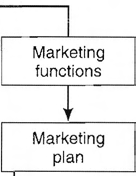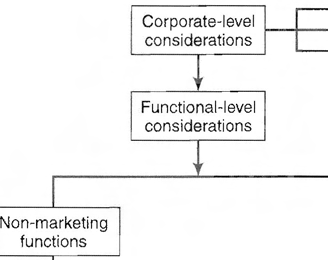CHAPTER 1
INTRODUCING MARKETING
the societal level and everyday consumption by the general public. Although there are many
variations of the marketing process, the one shown in Figure 1.1 will be employed in this
book. Our process begins with corporate-level considerations, which dictate the direction
the entire organization will take. The three corporate-level
listed here (mis-
sion, objectives, and strategy) are more precisely basic management topics, but are addressed
in passing in the following sections.
If a marketing firm is to adopt the customer-centered orientation discussed earlier, it must
also extend this philosophy to the other functions/institutions w i t h which it mu st interact.
These functions , and the institutions that perform the functions can be categori zed as non-
marketing institutions and marketing institutions.
Nonmarketing institutions can exist within the organization or outside the organiza-
tion. The former inciude accounting, financial planning, human resources, engineering, man-
ufacturing, research and development, and so on. Marketing must be familia; with the
capabilities of each of
functions and plan accordingly. Establishing and maintaining
rapport with leaders in these other functional areas is a challenge for every marketer. Non-
marketing institutions outside the firm facilitated the marketing process by providing experl-
ise in areas not directly related to marketing. Examples include financial institutions that
lend marketers necessary funds ; regulatory institutions that pass laws to allow marketers
to perform an activity; and the press, which tells the public about the activities of the marketer.
The M arketing Plan
To a great extent, the same sequence of activities performed at the corporate level is repeated
at the marketing level. The primary difference is that the marketing plan is directly influ-
enced by the corporate plan as well as tne role of the other functions within the organiza-
tion. Consequently, the marketing plan must always involve monitoring and reacting to
changes in the corporate plan.
Apart from this need to be flexible to accommodate the corporate plan, the market-
ing plan follows a fairly standardized sequence . The marketing plan begins with a mission.
A mission reflects the general values of the organization. What does it stand for? How does
it define integrity? How does it view the people it serves? Every organization has an explicit MARKETING CAPSULE
•
The characteristics of a marketing organization include:
6. Attempts at familiarity with the community
1. Maintenance of contact with consumers
The types of marketing:
2. Objective comparison of existing capabilities with ability
1. Macromarketing and rnicromarketing
to meet present and future consumer needs
2. Service marketing and goods marketing
3. Maintenance of a consistent message from all marketing
3. For-profit marketing and nonprofit marketing
elements to all consumer groups
4. Mass marketing, direct marketing, and Internet marketing
4. Thorough understanding of streng lhs and weaknesses of
competi tors
5. Local. regional , national, and international marketing
5. Understanding of the capabilities of other nonmarketing
6. Consumer goods marketing and business-to-business
functions
marketing






MARKETING: DEFINITION AND JUSTIFICATION
19
Mission
Objectives
Strategy
Human
resources
Mission
Situation
analysis
Objectives
Strategy
Implementation
Budgeting
Evaluation
FIGURE 1.1
The marketing process
or implicit mission. The corporate mission might contain words such as "quality," "global,"
"profitability," and "sacrifice." The marketing-level mission should extend the corporate mission by translating the latter into a marketing context. For example, a corporate mission
that focuses on technology might be accompanied by a production-oriented marketing mis-
sion. A corporation that stresses stockholders/dividends may result in a sales-orientation in
marketing. A corporate mission that concentrates on value or quality reflects a consumer-
oriented marketing mission. Once the mission is established, the situation analysis follows.
A marketing plan's situation analysis identifies factors, behaviors, and trends that have a direct bearing on the marketing plan . Much of this informatior. is usually collected simultaneously with the corporate information . However, collecting information about potential
and actual customers tends to be the concern of marketers. This is an ongoing activity and
represents a great deal of the marketer's ti me and money. (Chapter 2 describes the process
of
research.)
The situation analysis helps produce a relevant set of marketing objectives. At the
corporate level, typical objectives include profitability, cost savings, growth, market share
improvement, risk containment, reputation , and so on. All these corporate objectives can
imply specific marketing objectives. "Introducing a certain number of new products usu-
ally" may lead marketers to profitability, increased market share, and movement into new
markets. Desire to increase profit margins might dictate level of product innovation, qual-
ity of materials, and price charged.
The Marketing Mix
Once the objectives are established , the marketer must decide how to achieve these objec-
tives. This produces a set of general strategies that must be refined into actionable and achievable activities. The marketing mix-product, price, promotion, and distribution-represents


20











